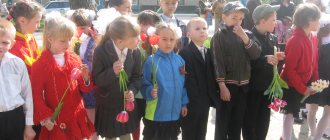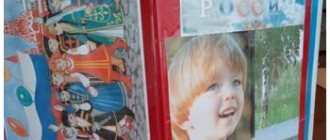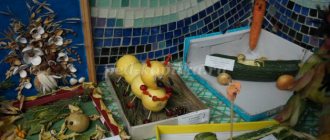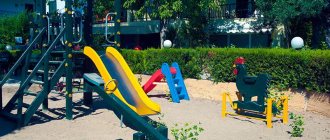Forms and methods of work to familiarize preschoolers with their native land
Aigul Khalimova
Forms and methods of work to familiarize preschoolers with their native land
«Forms and methods of work to familiarize preschoolers with their native land»
The methods of introducing children to their native land are varied . These are observations, walks, excursions; demonstration of illustrative material (photos, postcards, films and filmstrips)
;
widespread use of artistic works; conversations while walking; stories about the history of the city and its people, etc. It is very important to properly organize work with children , to be able to show the beauty of their native land , to expand the ideas that children have.
Classes are the leading form of organizing work to familiarize children with their native land . Classes with the entire group of children should be carried out at a strictly allotted time. They allow you to form knowledge about your native land , in a system and sequence, taking into account the age characteristics of children and the natural environment .
Under the guidance of the teacher, children develop a system of elementary knowledge in the classroom and develop basic cognitive processes and abilities. Classes to familiarize children with their native land are held in all kindergarten groups
The content of educational objectives includes informing children’s cognitive interest in nature and their native land . Along with educational tasks, educational tasks are also solved in the classroom. They are aimed at developing a careful , caring attitude towards the nature of their native land .
Excursions are one of the main types of activities and a special form of organizing work to familiarize children with their native land , one of the most labor-intensive and complex forms of education . This is a kind of outdoor activity. The advantage of excursions is that they allow to become acquainted with objects and natural phenomena in a natural setting. On excursions, children get acquainted with plants, animals and, at the same time, their living conditions, and this contributes to the formation of primary ideas about the relationships in nature and the education of a materialistic worldview in children. Excursions contribute to the development of observation skills and the emergence of interest in the nature of the native land . The teacher’s preparation consists, first of all, in determining the purpose of the excursion and selecting program content. The teacher plans an excursion based on the requirements of the program and the characteristics of the surrounding area. When determining the place of the excursion, the teacher chooses the best path to it - not tiring, not distracting the children from the intended goal. When determining the distance to a dream or excursion, one should take into account the physical capabilities of the children. Preliminary acquaintance with the place of the future excursion makes it possible not only to clarify and specify the plan, but also to think over the methods of conducting it. In order for the excursion to be interesting, the teacher needs to prepare poems, riddles, proverbs, and game techniques. Preparing children begins with the teacher telling them the purpose of the excursion. The guys need to know where they will go, why, what they will learn, what they need to collect.
A natural history excursion includes an introductory conversation, collective observation, individual independent observation of children, collection of natural history material, and children playing with the collected material. The order of the parts varies depending on the purpose of the excursion and the season. Having brought the children to the place of the excursion, you should remind them of its purpose in a short conversation and let the children look around. The main part of the excursion is collective observation, with the help of which all the main tasks of the excursion are solved. The teacher must help children notice and understand the characteristic features of objects and phenomena . To do this, you can use various techniques: questions, riddles, comparisons, investigations, games, stories, explanations. During excursions, an important place is given to questions and tasks that force children to examine an object, compare it with other objects, find differences and similarities, and establish connections between various natural phenomena. At the end of the main part, children must be given the opportunity to satisfy their curiosity in individual independent observations and collection of natural history material. However, we should not forget about environmental protection. The collection of material must be strictly limited and carried out under the guidance or with the direct participation of the teacher. When children perform independent work , the teacher should not remain a passive observer. Sometimes you need to show the kids how to use, for example, a shovel, or how to dig up plants. However, assistance should not be limited to doing work for children . During children's rest, games and play exercises are held. Children consolidate knowledge about the characteristic features of an object, express in words the quality of an object, and remember the names of plants. In the final part of the excursion, the teacher once again draws the children’s attention to the overall picture of nature.
Work after the excursion . Immediately upon returning from the excursion, the collected material is placed in a corner of nature and on the site. The collected material can be presented in the form of herbariums and visual aids. 2-3 days after the excursion, a lesson should be held using handouts, drawing, modeling, didactic games with natural materials , reading fiction, children’s stories about where they have been and what they have seen, and a general conversation should be organized.
Conversational conversation is important. It is used to generalize knowledge, form elementary concepts, and makes children think more deeply about what they see. When talking with children, the teacher should pose questions in such a way that the entire course of the excursion is restored in their memory. It is important to emphasize the most important educational and educational points, to lead children to conclusions and generalizations.
Walks. Walks are widely used to introduce children to nature . They provide an opportunity for children to accumulate ideas about natural phenomena that occur over a long period of time. The teacher introduces pupils to the daily changes in nature by season (length of day, weather, changes in the life of plants and animals, human labor), organizes a variety of games with natural materials - sand , clay, water, ice, leaves, etc. Children accumulate sensory experience, curiosity and observation are cultivated. Walking gives children joy and pleasure from communicating with nature and helps them feel its beauty. When conducting walks, various forms of organizing children (entire group, small subgroups, individually)
.
When conducting collective observations, the same techniques are used as in the classroom: questions, riddles, comparisons, survey activities, artistic expression, etc., however, given that children are exposed to a variety of stimuli during walks, observations are carried out briefly and repeatedly are repeated. During walks, individual observations are carried out. It is important to awaken children’s independent thinking, teach them to notice new things, and draw on existing experience. To do this, you should support independent observations, ask questions, give explanations, and sometimes teach them to observe. A variety of game exercises are widely used to recognize trees, shrubs, flowers, animals (by sounds and traces, etc., games with toys driven by the wind. Starting from the second youngest group, targeted walks around the site are carried out, going beyond its boundaries Taking into account the natural environment of the kindergarten, the most striking seasonal natural phenomena, the children's capabilities, the work , the teacher decides where to go and what to see. Targeted walks, unlike excursions, are short-term, and a small amount of problems are solved during them. Children get acquainted with bright natural phenomena of a particular season, for example, nesting of rooks, ice drift.
The prominent Russian psychologist S. L. Rubinstein considers observation as the result of meaningful perception, during which the development of mental activity occurs. He connects the development of various forms of perception and observation with content. On the one hand , observation is a source of knowledge, on the other hand, it itself requires the presence of certain knowledge as the starting points of observation. Meaningful perception of objects begins early . However, the little experience and knowledge of a small child does not allow him to see the essential aspects of objects . Perception is captive of motor and emotional reactions. Vivid impressions, primarily from rapidly changing, moving objects and phenomena , are the result of involuntary observations of children. On the other hand, in its highest manifestation, observation is an activity independently organized by the observer himself.
Children must learn: to distinguish, to simply examine objects of living and inanimate nature; monitor them; express your feelings in relation to observed phenomena and objects using verbal and non-verbal means of communication; compare natural objects at different times of the year according to a certain plan; establish, with the help of a teacher, the simplest cause-and-effect relationships of observed natural phenomena ; formulate your attitude to what is observed and be able to explain what causes certain feelings; know and name the main signs of different seasons, be able to describe them expressively.
Didactic games with local history content create great opportunities for implementing a program for environmental education of preschoolers . After all, every place in our country has its own clean river, or stream, or something that is unique to this place, that all its inhabitants, including the smallest ones, love. that will satisfy children's curiosity , involve the child in the active exploration of the world around him, and help him master ways of understanding the connections between objects and phenomena: “By reflecting impressions of life phenomena in the images of the game, children experience aesthetic and moral feelings. The game contributes to children’s in-depth experience and expands their understanding of the world.”
Games are of great importance in satisfying the cognitive needs and interests of children in environmental education. They develop attention, visual memory, hearing, and smell, which makes it possible to more fully perceive the natural world around us.
If during a lesson the teacher carries out so-called direct teaching, then in a didactic game cognitive tasks are combined with gaming ones, which makes the didactic game a special form of learning - easy , quick and unintentional acquisition of knowledge by children. Children learn by playing. Children should not be forced to play. They play spontaneously, willingly, and with pleasure.
Local history games bring children together, develop their activity, curiosity , imagination, and creativity. Therefore, we believe that local history games are powerful pedagogical tools in the environmental education of older preschoolers .
Children's experimentation is an effective method of understanding the patterns and phenomena of the surrounding world. The development of the theoretical foundations of the method of children's experimentation in preschool institutions is carried out by a creative team of specialists under the leadership of professor, academician of the Academy of Creative Pedagogy and the Russian Academy of Education N. N. Poddyakov. The main advantage method is that it gives children real ideas about the various aspects of the object being studied, about its relationships with other objects and with the environment. During the experiment, the child’s memory is enriched, his thought processes are activated, since the need constantly arises to perform operations of analysis and synthesis, comparison and classification, generalization and extrapolation. The need to give an account of what was seen, to formulate discovered patterns and conclusions stimulates the development of speech. The consequence is not only familiarization with new facts, but also the accumulation of a fund of mental techniques and operations that are considered as mental skills. It is impossible not to note the positive impact of experiments on the emotional sphere of the child, on the development of creative abilities, on the formation of work skills and the promotion of health by increasing the general level of motor activity. Children love to experiment. This is explained by the fact that they are characterized by visual-effective and visual-figurative thinking, and experimentation, like no other method , corresponds to these age-related characteristics. In preschool age it is the leader, and in the first three years it is practically the only way to understand the world around us . Experimentation has its roots in the manipulation of objects, as L. S. Vygotsky repeatedly spoke about. When forming the foundations of natural science and environmental concepts, experimentation can be considered as a method close to ideal. Knowledge gleaned not from books, but acquired independently, is always conscious and more durable . The use of this method was advocated by such classics of pedagogy as J. A. Komensky, I. G. Pestalozzi, J. -J. Russo, K.D. Ushinsky and many others. Thus, it is impossible to deny the validity of the statement that observations and experiments form the basis of all knowledge, that without them any concepts turn into dry abstractions.
N. N. Poddyakov writes: “The fundamental fact is that the activity of experimentation permeates all spheres of children’s life, all children’s activities, including play. The latter arises much later than the activity of experimentation.”
Thus, it is very important, through various forms and methods of work on environmental and moral education, to help bring curious and inquisitive preschoolers closer to the environment , to get to know and explore their native land .



